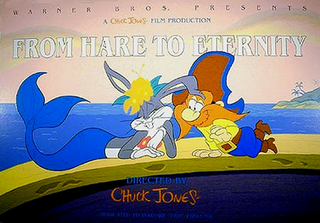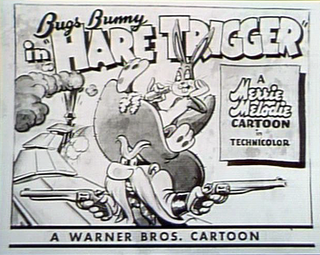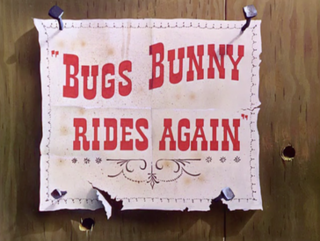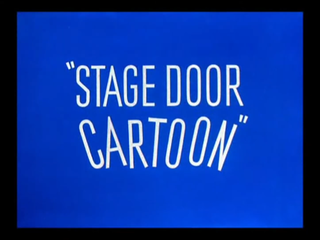Related Research Articles

Yosemite Sam is a cartoon character in the Looney Tunes and Merrie Melodies series of short films produced by Warner Bros. His name is taken from Yosemite National Park in California. He is an adversary of Bugs Bunny and his archenemy alongside Elmer Fudd. He is commonly depicted as a mean-spirited and extremely aggressive, gunslinging outlaw or cowboy with a hair-trigger temper and an intense hatred of rabbits, Bugs in particular. In cartoons with non-Western themes, he uses various aliases, including "Chilkoot Sam" and "Square-deal Sam" in 14 Carrot Rabbit, "Riff Raff Sam" in Sahara Hare, "Sam Schultz" in Big House Bunny, "Seagoin' Sam" in Buccaneer Bunny, "Shanghai Sam" in Mutiny on the Bunny, "Von Schamm the Hessian" in Bunker Hill Bunny, "Baron Sam von Schpamm" in Dumb Patrol, and many others. During the golden age of American animation, Yosemite Sam appeared as antagonist in 33 animated shorts made between 1945 and 1964.

From Hare to Eternity is a Looney Tunes cartoon directed by Chuck Jones released on November 4, 1997.

Hare Trigger is a 1945 Merrie Melodies cartoon directed by Friz Freleng. The cartoon was released on May 5, 1945, and features Bugs Bunny. The short featured the first appearance of Yosemite Sam, as well as the first short to credit (almost) the whole animation staff who worked on the short.
High Diving Hare is a 1948-produced Warner Brothers Looney Tunes theatrical cartoon short starring Bugs Bunny and Yosemite Sam. Released to theaters on April 30, 1949, the short is an expansion of a gag from Stage Door Cartoon, which was also directed by Friz Freleng, and co-stars Elmer Fudd. High Diving Hare can be seen in the third act of The Looney Looney Looney Bugs Bunny Movie, and a segment can be seen in the special Bugs Bunny's Wild World of Sports.

Bugs Bunny Rides Again is a 1948 Merrie Melodies animated short directed by Friz Freleng. The short was released on June 12, 1948, and stars Bugs Bunny and Yosemite Sam.

The Looney Looney Looney Bugs Bunny Movie is a 1981 American animated comedy package film with a compilation of classic Looney Tunes/Merrie Melodies Warner Bros. cartoon shorts and animated bridging sequences produced and directed by Friz Freleng, hosted by Bugs Bunny. The new footage was produced by Warner Bros. Animation. It was the first Looney Tunes/Merrie Melodies film with a compilation of classic cartoon comedy shorts produced by Warner Bros. Animation.

Stage Door Cartoon is a 1944 Merrie Melodies cartoon directed by Friz Freleng. The short was released on December 30, 1944, and features Bugs Bunny and Elmer Fudd.

Roman Legion-Hare is a 1955 Warner Bros. Looney Tunes animated short directed by Friz Freleng. The short was released on November 12, 1955, and stars Bugs Bunny and Yosemite Sam. The title is a play on the words Roman Legionnaire. After being ordered by Emperor Nero to find a victim to be tossed to the lions, Yosemite Sam tries to capture Bugs Bunny.

14 Carrot Rabbit is a 1952 Warner Bros. Looney Tunes animated cartoon short directed by Friz Freleng. The short was released on March 15, 1952, and features Bugs Bunny and Yosemite Sam. The title is a play on "14 karat", as in a purity level for gold.

Sahara Hare is a 1955 Warner Bros. Looney Tunes theatrical cartoon short directed by Friz Freleng. The short was released on March 26, 1955, and stars Bugs Bunny and Yosemite Sam.

Rabbitson Crusoe is a 1956 Warner Bros. Looney Tunes short directed by Friz Freleng. The short was released on April 28, 1956, and stars Bugs Bunny.
Hare Lift is a 1952 Warner Bros. Looney Tunes short directed by Friz Freleng. The short was released on December 20, 1952, and stars Bugs Bunny and Yosemite Sam. The title is a play on the term "air lift," as expressed in the plotline.
The Bugs Bunny Mystery Special is an animated television special that was broadcast on CBS October 15, 1980. Presented by Porky Pig as an Alfred Hitchcock-style whodunit, the plot is modeled after those of North by Northwest and The Fugitive.

Rabbit Every Monday is a 1951 Warner Bros. Looney Tunes cartoon directed by Friz Freleng. The short was released on February 10, 1951, and stars Bugs Bunny and Yosemite Sam. The title is a play on Chicken Every Sunday.

A Star Is Bored is a 1956 Warner Bros. Looney Tunes cartoon, directed by Friz Freleng. The short was released on September 15, 1956, and stars Bugs Bunny and Daffy Duck. The cartoon expands upon the rivalry depicted between Bugs and Daffy, in such films as Chuck Jones' 1951 short Rabbit Fire, this time placing the action in a show-biz setting. In this 7-minute short, Daffy must double for Bugs in any slapstick that Warners deems too dangerous for its top star. After each disaster, Daffy shouts "MAKEUP!". The director directing the scenes has an Erich Von Stroheim accent.
The Fair-Haired Hare is a 1951 Warner Bros. Looney Tunes cartoon starring Bugs Bunny and Yosemite Sam. Released April 14, 1951, the cartoon was directed by Friz Freleng. The voices were performed by Mel Blanc.

Wild and Woolly Hare is a 1959 American animated Western comedy short film directed by Friz Freleng and written by Warren Foster. The short was released on August 1, 1959 by Warner Bros. Pictures as part of the Looney Tunes series, and features Bugs Bunny and Yosemite Sam.
References
- ↑ Beck, Jerry; Friedwald, Will (1989). Looney Tunes and Merrie Melodies: A Complete Illustrated Guide to the Warner Bros. Cartoons. Henry Holt and Co. p. 323. ISBN 0-8050-0894-2.
- ↑ Lenburg, Jeff (1999). The Encyclopedia of Animated Cartoons . Checkmark Books. pp. 60-62. ISBN 0-8160-3831-7 . Retrieved June 6, 2020.
- ↑ Watson, Pernell (June 12, 2001). "Network pulls Bugs Bunny shows". Daily Press . Archived from the original on April 5, 2023. Retrieved June 19, 2022.